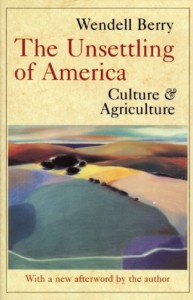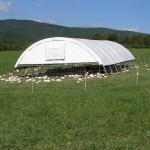 Beck Bennet poses a simple question to a group of children. Their imaginative, silly, and generally unscripted responses have resulted in advertising gold, as the commercials have “consistently ranked in the top three most talked-about spots” according to a recent article in Advertising Age (view the article here). While the campaign garners ad world praise and water-cooler talk, it is emblematic of the nearly-universal acceptance of many of the principles critiqued by Wendell Berry in The Unsettling of America: Culture & Agriculture.
Beck Bennet poses a simple question to a group of children. Their imaginative, silly, and generally unscripted responses have resulted in advertising gold, as the commercials have “consistently ranked in the top three most talked-about spots” according to a recent article in Advertising Age (view the article here). While the campaign garners ad world praise and water-cooler talk, it is emblematic of the nearly-universal acceptance of many of the principles critiqued by Wendell Berry in The Unsettling of America: Culture & Agriculture.In one of the spots, Bennet asks the children, “What’s better, faster or slower?” The children respond with shouts of “Faster!” When asked what’s slow, one of the children observes that his grandma is slow. The solution offered to make her faster is to “Tape a cheetah to her back.” The announcer at the end makes sure the message has been conveyed, saying, “It’s not complicated, faster is better.” (You can view the ad here.) Others carry similar messages, including “Bigger is better,” as evidenced by the fact that a bigger treehouse can better fit a large screen t.v. than a smaller treehouse can.
Are the kids hilarious? Absolutely. Are the spots entertaining? Sure. But their messages are not only disturbing, they also carry an unarticulated threat against any who would question their presuppositions. Since even children know that these value-laden evaluations are absolutely true, it must be obvious that only a complete idiot could ever question AT&T’s assumptions that faster is better, that bigger is better. And while faster upload speeds and wider network coverage are certainly values for cellular providers, America needs no more reinforcement of its delusions that faster is inherently better than slower, or that bigger is inherently better than smaller.
Berry observes that, “What has drawn the Modern World into being is a strange, almost occult yearning for the future,” that led us to crave “things that were up-to-date,” rather than things that were excellent, or even adequate (56, 58). This craving is perfectly illustrated in the cellular industry, which garners enormous profits off of the “built-in panic” that comes with the spectre of being out-of-date. Apple released the first iPhone in June of 2007. Five years later, they released the fifth generation of iPhone in September of 2012. My unscientific guess is that the record earning posted by Apple were largely (although not entirely) fueled by those who purchased the newest model upon its release (which would amount to a new $600 phone every year), or at least long before the old phone lost its usefulness. 3G is better than 4G, slow uploading time slows down your life, the newest, fastest, biggest is the best, and you need it now in order to have a fulfilling life. But as Berry notes, “our possessions cannot be up-to-date more than momentarily” (58). Corporations thrive off the consumer’s need to have the latest model, and excellence disappears when nothing needs to last longer than the release date of the next iteration.
In response to the damage created by this model of consumption, Berry advocates that standards of health should replace standards of efficiency in deciding how to inhabit this world of ours. I would argue that those who embrace Berry’s viewpoint should not surrender the word efficiency to corporations and politicians hell-bent on increasing profits at any cost. Although in modern usage, efficiency is nearly universally concerned with time and money, its meaning can be expanded or its focus shifted to recapture Berry’s concerns as well. As Merriam-Webster’s definition of efficiency points out, it has to do with a comparison of production with cost. Cost does not have to mean only money or time–it can and should include the various injuries and illnesses that have long been left out of the equation when corporations and their economists argue for the efficiencies of size. In the agricultural realm, this would include the pollution, erosion, and contamination that agribusiness often overlooks. In the industrial realm, it would mean calculating the cost of pollution, waste, and contamination involved in production as well. And in both the agricultural and industrial realm, it should include the impact of mechanization on human individuals, communities, and cultures.
As Berry points out, agribusiness arguments to the contrary, “large farms do not produce as abundantly or efficiently as small ones” (166). Their lauded “greater efficiency” comes in the greater production of food per employed human being, but not per square acre. In other words, smaller farmers produce more food per square acre than the giant corporate farms can. Now, land is a limited quantity, and unemployment is a persistant plague. Why should we continue to put people out of work so that we can produce less food on the same amount of land, while simultaneously harming it for future production? Farming does not need to be done this way.
In 1961, the Salatin’s purchased an over-farmed, broken-down piece of land in Virginia, and they have spent over a half century healing it while making a living, and even a profit, in doing so. By allowing the animals they raise to eat the foods and live the lives they were designed for, the Salatins are able to produce many times more goods annually than those who follow factory-farm practices nearby. They produce pork, beef, chicken, turkey, eggs, rabbits and lumber, and they do it while they increase the health and fertility of their land. Featured in the documentary, Fresh, Polyface Farms provides an example of small farming at its best. Their cows eat grass, their poultry spreads manure, the hooves and claws of the animals aerate the fields. They do what they naturally do, and it forms an environmentally healing, healthful cycle.
We need to beware anytime someone tells us, “It’s not complicated.” On one level, what Berry proposes and the Salatin’s enact is not complicated–it is the most natural approach to agriculture that there is. But they are only able to take such an approach because they recognize that it is complicated, that agricultural problems have to be solved within agricultural environments and cycles, not abstracted from them. The same holds true for other human problems as well–they are complicated, and they cannot be abstracted from human environments and life cycles, which are interdependent with the rest of the environment and natural cycles as well. Sometimes, faster and bigger might be better. But making such an evaluation would require calculating all of the costs for the benefits that are being lauded, rather than ignoring the catastrophic destruction that some innovations bring. Sometimes, slower and smaller is better. But that’s something the corporations would never want you to know.

